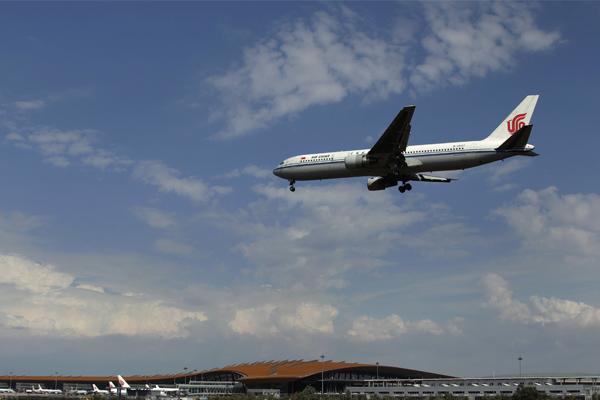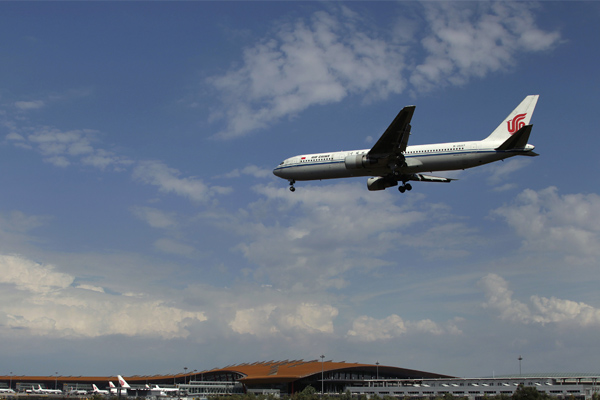
Aviation talks between the U.S. and China have hit a stumbling block over airport access, report Fang Yan and Jeffrey Dastin. Also, China’s aviation boom is driving an airport-building frenzy.
Skip to
Talks to ease limits on flights between the United States and China’s gateway cities have stalled over U.S. fears its airlines will be given less attractive time slots for take-off and landing than their Chinese rivals, people familiar with the negotiations said.
Travel demand by an increasingly affluent Chinese population is set to soar long-term, a huge business opportunity for both countries’ carriers. But China’s major airports are already heavily congested, lim-iting the potential for good slots and creating a roadblock to an aviation accord that would deepen ties between the world’s two largest economies.
In exploratory talks held in May in Washington, details of which have not previously been reported, China offered to permit more flights to and from Beijing, Shanghai and Guangzhou while lowering caps for other domestic cities, U.S. officials said.
The talks, the first in four years, ended with the U.S. side refusing to pursue formal negotiations until China presents plans to reform what the United States calls an opaque allocation system that tends to give big Chinese state carriers the best time slots, the U.S. officials told Reuters in a telephone interview.
A senior Chinese aviation official said the U.S. was dragging its feet.
“In the past, the Chinese side was not as enthusiastic as the Americans when it came to market liberalization because we didn’t need that many flights,” the source told Reuters. “But it’s the other way around now.”
Washington has made clear the ball is in Beijing’s court and is waiting for the Chinese side to respond, one person said. It has encouraged China to follow guidelines from the International Air Transport Association (IATA) to accommodate carriers despite congestion.
Officials from both countries spoke on condition of anonymity. China’s aviation regulator did not respond to requests for comment.
While there is interest in a new bilateral air services pact, industry experts say an ‘Open Skies’ agreement, which would remove market restrictions and allow airlines to coordinate capacity and pricing if they have government approval, is likely years away.
Back to topHUGE DEMAND SEEN
Under existing agreements, Chinese passenger carriers are limited to 180 round-trip flights per week, while U.S. passenger carriers are allotted 160 weekly round-trip flights between the United States and three of China’s mega cities.
But airlines are already brushing up against these limits. The top four Chinese airlines have on average scheduled 148 round-trip flights per week from July through September this year, while their U.S. rivals have hit 128 weekly round-trips on average, according to aviation data and analytics company OAG.
Moreover, the number of air passengers traveling to, from and within China is set to nearly triple by 2034 to some 1.3 billion, surpassing an expected 1.2 billion for the United States, according to IATA.
Although China is investing heavily in new airports, its major airports are operating at above or near capacity, limiting the country’s ability to assign new attractive time slots to carriers equally. Military restrictions on flight paths are also exacerbating congestion.
Industry experts say U.S. airlines could end up less commercially competitive if Washington were to rush into a deal that resulted in bad flight times and lengthy layovers for their connecting passengers.
“They would be losing a lot of money running flights that arrive and depart in the middle of the night,” Joe Tymczyszyn, former executive director of the US-China Aviation Cooperation Program, told Reuters. He did not speak on behalf the program.
Capping capacity for the time being helps U.S. airlines, the most profitable in aviation, as they try not to overshoot demand to keep fares from falling.
Airlines for America, the trade group representing the largest U.S. carriers, said in a statement it supports efforts to liberalize aviation markets even though challenging issues must still be resolved.
An executive at state-controlled Air China Ltd said the airline had not been affected by the slow pace of bilateral talks but might be in the future if it needed to add more flights.
In the long run, the biggest U.S. carriers are keen on an Open Skies agreement as it would allow airline partners to request immunity from antitrust law. Joint ventures with Chinese carriers could then crowd out smaller competitors and boost profits on trans-Pacific routes.
United Continental Holdings Inc has told investors of its interest in a Chinese joint venture once Open Skies are in place.
Delta Air Lines Inc is set to become the first U.S. airline to own part of a Chinese peer, announcing plans last month to buy a 3.55 percent stake in China Eastern Airlines Corp Ltd for $450 million and gaining an “observer” seat on the Chinese carrier’s board.
China’s aviation boom drives airport building frenzy
By Fang Yan and Matthew Miller
When Mangshi opened its airport two decades ago, the small tropical city on China’s border with Myanmar was served by few airlines. China’s recent travel boom has changed that - seven carriers brought in more than 1 million visitors last year.
“We had a hard time attracting airlines in the early days,” Li Ping, deputy chief of the airport’s expansion steering committee, told Reuters. “Now we are struggling to accommodate flights.”
Mangshi is one of more than 60 inland airports under expansion, with another 30 new regional airports being built. Government planners estimate China’s airports will increase to 240 by 2020 from around 200 today.
Li Jiaxiang, head of the Civil Aviation Administration of China (CAAC), said this week the country would invest $80 billion in aviation projects this year alone.
The aviation market is being lifted by rising business travel and a surge in outbound tourism fueled by an increasingly wealthy middle class in coastal and inland cities.
The number of leisure travelers going overseas for the first time topped 100 million in 2014, official data shows. Foreign travel is tipped to grow another 10 percent this year as the United States, France and Australia ease visa policies.
That has prompted Air China, China Eastern Airlines and China Southern Airlines to fly to New York, Paris and Sydney from Nanjing, Wuhan or Chengdu, or at least with a stopover in those second-tier cities.
China’s so-called Silk Road initiative is also certain to boost traffic. Under the scheme, the government aims to extend its economic and political influence to neighboring countries. A network of railways, highways and new air routes are part of the plan.
Last year passenger volumes at Chengdu’s Shuangliu airport and Chongqing’s Jiangbei airport rose 12.6 percent and 15.8 percent, respectively, beating Beijing’s 2.9 percent gain and Guangzhou’s 4.4 percent increase.
Xiamen’s Gaoqi airport handled 20.9 million passengers, far exceeding its designed capacity of 15 million, while Dalian is expected to hit full capacity in 2016.
Skeptics warn about white elephant projects such as the barely used $6 million airport in Dachangshan Island off China’s northeast coast. Many existing airports are also in losses due to huge upfront investments.
CAAC’s Li said the country’s airport expansion is supported by data showing rising passenger numbers.
“Airport building should be a bit ahead of the demand. Judging from the experience of the developed world, our airport construction is far from enough,” Li said. “We are still unable to catch up with demand.”
Back to topFRANTIC BOOM
Earlier this month, China approved four additional new airports in provinces including Xinjiang and Heilongjiang, costing 16.3 billion yuan ($2.63 billion).
Chongqing, an industrial city in the southwest, is in the middle of a 29.4 billion yuan expansion. A little over three hundred kilometers to the northwest, Chengdu is preparing to build a second airport with six runways and four terminals at a cost of 69.3 billion yuan.
“The Chengdu airport is very busy and discount air fares are hard to get,” Rose Wang, a business woman who often shuttles between Shanghai and Chengdu, told Reuters. “Thirty or 40 percent dis-counts were normal previously.”
On the coast, Xiamen and Dalian are creating artificial islands for new airports, with landfill effort in Dalian alone costing 26.3 billion yuan.
The aviation boom is boosting sales for global suppliers Thales SA, Indra Industries, Raytheon Co, Lockheed Martin Corp and Honeywell Aerospace.
In May, Honeywell tested its next generation GPS-based precision landing system at Shanghai’s Pudong airport.
Thales has sold 40 air traffic management (ATM) radars in China. It supplies ATM systems to the crucial Beijing, Shanghai and Guangzhou sectors, and has recently added Urumqi in Xinjiang to its client list.
“Demand for navigation systems will be on the rise as more airports are built or expanded which will also result in more demands in ATM systems as well as surveillance technologies,” Xia Jinsong, deputy chief executive officer with Thales China, told Reuters. “That means more business opportunity for us.”
In Mangshi, where passenger volume is expected to exceed the designed capacity of its airport, a more urgent issue is at hand.
Its runway needs to be extended by 400 meters to 2,600 meters to handle Junyao Airlines’ A320 and Xiamen Airlines’ B737-800 jets. Only B737-700 and A319 jets can fly in for now.
“We have to keep the airlines waiting as our runway is too short and not safe enough for bigger planes,” said Li of the airport’s expansion committee.
Back to top


